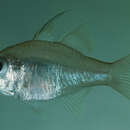pms
nòm ant ël fil


Zoramia leptacantha és una espècie de peix pertanyent a la família dels apogònids.
És un peix marí, associat als esculls de corall[6] de les espècies Porites cylindrica i Porites andrewsi, i de clima tropical (30°N-23°S) que viu entre 1 i 12 m de fondària a badies i llacunes. Forma grans moles, sovint amb altres espècies com ara Archamia fucata i Archamia zosterophora.[5][7][8]
Es troba des del mar Roig i l'illa de Moçambic[9] fins a Samoa,[10] Tonga, les illes Ryukyu,[11] Nova Caledònia[12] i la Micronèsia.[13][5][14][15][16][17][18][19][20][21][22][23][24][25][26][27][28][29][30][31][32][33][34][35]
És inofensiu per als humans i de costums nocturns.[36][5]
Der Fadenflossen-Kardinalbarsch (Zoramia leptacantha) oder Neon-Kardinalbarsch ist ein Schwarmfisch aus der Familie der Kardinalbarsche (Apogonidae).
Er lebt im Roten Meer und im Indopazifik, von Mosambik bis zu den Ryūkyū-Inseln und Tonga. Tagsüber hält er sich zwischen astförmigen Steinkorallen versteckt, um in der Dämmerung nach Plankton zu jagen. Er schwimmt oft in gemischten Schwärmen mit den Kardinalbarschen Archamia fucata und Archamia zosterophora.
Wie alle Kardinalbarsche sind die Fadenflossen-Kardinalbarsche Maulbrüter. Sie werden sechs Zentimeter lang.
Der Fadenflossen-Kardinalbarsch (Zoramia leptacantha) oder Neon-Kardinalbarsch ist ein Schwarmfisch aus der Familie der Kardinalbarsche (Apogonidae).
Er lebt im Roten Meer und im Indopazifik, von Mosambik bis zu den Ryūkyū-Inseln und Tonga. Tagsüber hält er sich zwischen astförmigen Steinkorallen versteckt, um in der Dämmerung nach Plankton zu jagen. Er schwimmt oft in gemischten Schwärmen mit den Kardinalbarschen Archamia fucata und Archamia zosterophora.
Wie alle Kardinalbarsche sind die Fadenflossen-Kardinalbarsche Maulbrüter. Sie werden sechs Zentimeter lang.
The threadfin cardinalfish or bluestreak cardinalfish, Zoramia leptacantha,[1] it is one of the cardinalfishes found in the Red Sea and off Mozambique Island to Samoa and Tonga, north to Ryukyu Islands, and south to New Caledonia and Micronesia.[2]
A translucent fish with vertical iridescent blue lines on the head and front of body, it grows up to 6 cm in length. In juveniles, the blue lines are missing. Adults occur in small aggregations from 1 to at least 12 m deep, usually close to branching coral, in sheltered bays and lagoons.
The threadfin cardinalfish or bluestreak cardinalfish, Zoramia leptacantha, it is one of the cardinalfishes found in the Red Sea and off Mozambique Island to Samoa and Tonga, north to Ryukyu Islands, and south to New Caledonia and Micronesia.
A translucent fish with vertical iridescent blue lines on the head and front of body, it grows up to 6 cm in length. In juveniles, the blue lines are missing. Adults occur in small aggregations from 1 to at least 12 m deep, usually close to branching coral, in sheltered bays and lagoons.
Apogon leptacanthus es una especie de peces de la familia de los apogónidos en el orden de los perciformes.
Los machos pueden llegar alcanzar los 6 cm de longitud total.[2]
Se encuentran desde el Mar Rojo hasta Samoa, Tonga, las Islas Ryukyu, Nueva Caledonia y Micronesia.[2]
Apogon leptacanthus es una especie de peces de la familia de los apogónidos en el orden de los perciformes.
Zoramia leptacantha Zoramia generoko animalia da. Arrainen barruko Actinopterygii klasean sailkatzen da, Apogonidae familian.
Espezie hau Agulhasko itsaslasterran aurki daiteke.
Zoramia leptacantha Zoramia generoko animalia da. Arrainen barruko Actinopterygii klasean sailkatzen da, Apogonidae familian.
Viiruposkikardinaaliahven (Apogon leptacanthus) on kardinaaliahveniin kuuluva kala.
Viiruposkikardinaaliahven kasvaa noin 6 cm pitkäksi. Sen vartalo on pyöreähkö, evät kapeat ja korkeat. Pohjaväri on hopeanharmaa, lähes läpikuultava. Se on saanut nimensä kellertävistä ja sinisistä viiruista kalan poskessa kiduskannen kohdalla.
Viiruposkikardinaaliahven elää luonnossa Intian valtameressä.
Viiruposkikardinaaliahven ei näyki koralleja, joten se sopii myös riutta-akvaarioon. Luonnossa se piileksii meriheinän tai jopa merisiilin piikkien joukossa. Jos viiruposkikardinaaliahvenia on akvaariossa parvi, ne muodostavat tarkan nokkimisjärjestyksen, mutta eivät käytä väkivaltaa sen ylläpitämiseen.[1]
Viiruposkikardinaaliahven syö lihapitoista ruokaa.[2]
Viiruposkikardinaaliahven (Apogon leptacanthus) on kardinaaliahveniin kuuluva kala.
Zoramia leptacantha est un poisson présent dans la région Indo-Pacifique : de la Mer Rouge à la Nouvelle-Calédonie. Sa taille maximale connue est de 6 cm.
Zoramia leptacantha est un poisson présent dans la région Indo-Pacifique : de la Mer Rouge à la Nouvelle-Calédonie. Sa taille maximale connue est de 6 cm.
Zoramia leptacantha is een straalvinnige vissensoort uit de familie van kardinaalbaarzen (Apogonidae).[1] De wetenschappelijke naam van de soort is voor het eerst geldig gepubliceerd in 1856 door Pieter Bleeker.[2]
De soort werd ontdekt in de zee rond het eiland Ternate in Nederlands-Indië.
Bronnen, noten en/of referentiesZoramia leptacantha[1] – gatunek morskiej ryby z rodziny apogonowatych. Bywa hodowana w akwariach morskich.
Morze Czerwone, Ocean Indyjski i zachodni Ocean Spokojny do Nowej Kaledonii. Zasiedlają rafy na głębokościach od 1 – 12 m.
Dorastają do 6 cm długości.
Zoramia leptacantha – gatunek morskiej ryby z rodziny apogonowatych. Bywa hodowana w akwariach morskich.

Apogon leptacanthus
英名 Threadfin cardinalfishイトヒキテンジクダイ (糸引天竺鯛、Zoramia leptacanthus、英:Threadfin cardinalfish)は、スズキ目スズキ亜目テンジクダイ科に属する魚類。
日本の沖縄などサンゴ礁域に生息する。繁殖期は、縄張りを作りやすい枝サンゴの間など障害物の周りに集まる。沖縄ではときおり、モモイロテンジクダイと共に漁港で釣れることがある。太平洋のサンゴ礁域では比較的見られるようだ。多種と混泳していることもある。区別の方法は下の近い仲間の見分け方で述べる。
最大全長6.0cm、平均的な全長は5.0cm。夜行性であるが昼間はサンゴの間を群れて漂っている。体色はメタリックな体に頭部から鰓付近をブルーの横ラインが複数通る。テンジクダイ科は地味な体色の仲間が多いが、本種はたいへん美しい体色である。本種も口内保育いわゆるマウスブルーダー(親魚が受精卵を孵化するまで口にくわえて保護する)である。そのため、夏場繁殖期はペアーで群れからはずれ縄張りを作る。卵の保護は基本的に雄が行う。繁殖後雌は餌を捕食後また別の雄とペアーを組み繁殖をする。卵は孵化まで1週間掛かり、その間雄は何も口にしない。雄と雌の見分け方は、繁殖期は雌は腹に卵があると丸い体形をしているが、雄は第2背びれが長く伸びる。これで雌雄の区別ができる。
食用としては流通しない。主にダイバーなどがダイビングやスノーケルの時に見ることができる。また、近年飼育用としても流通しており、比較的一般の人も見ることがある魚である。テンジクダイ科で観賞用として有名なのはマンジュウイシモチ、キンセンイシモチなどと並び水槽内の脇役的存在である。それ以外にもテンジクダイ科の中では美しい姿のため、水族館でも良くサンゴ水槽などの中で混泳させている。
本種を含め、この種全般は飼育可能である。しかし、知名度があまりにも低いため、詳しい飼育法がない。ここではイトヒキテンジクダイについて書くが、テンジクダイ科全種に応用が利く。
南方系の魚なので冬場、水温を最低でも22度以下にはしないこと。ネンブツダイは、基本的に近海魚なので水温に敏感にならなくても良いが、18度を下回らないほうが望ましい。本種はかなりデリケートなので、気が強い魚や噛み付く魚(スズメダイ類、ハギ類、フグ類など)とは避けて飼育する。また、ハナダイ類を飼育したことがある者は解かると思うが、単独飼育よりは複数飼育が向いている(この点は、ハナダイ類と似ている)。水槽のサイズは、最低でも60cm水槽が望ましい。飼育する場合は、飼育開始予定日または採集予定日より、1週間前に水槽をセットする(セットするとは「水を水槽に入れ、ろ過装置や水温調整器具をセットし、電源を入れること」である。漏電には十分注意すること)。ろ過装置、ヒーター(冬場)、水槽用クーラー(夏場)、殺菌灯などが必要だろう。水は当たり前だと思うが、海の生物なので人工海水または天然海水を使う。そして、水温計があると何かと便利で安心して楽しめる。
入手するには以下の2点が挙げられる。
後は、水槽に魚を入れる時だが、他の海水魚や熱帯魚と同様導入前に水温と水質調整を行うこと。早く入れたい気持ちは解かるが、これを怠ると水槽内でショックし、最悪の場合死に至る。だいたい30分ほど入れると良い(30分は普通より長めだと思うかもしれないが、デリケートな魚なので長めにやることをお勧めとする)。この作業が出来たら早速水槽へとなるが、網で追い回したり、掬ったりしないこと(スレの原因になる)。必ず、小型のプラケースで水ごと掬い少しずつ水を捨てる(この場合全ての水は捨てずに、魚が水に浸かる程度は残す)。そしてこのまま水槽へ(若干元の海水が入るが魚がスレるよりはマシなので入ってしまってもかまわないが、薬が入っている場合は新鮮な水に魚を移してからこの作業をする。この場合は、網でスレないように注意して移動する。)。
※この作業は、水槽掃除の時の移動時も同じことである。
特にまず、導入してからの1週間は注意する。なぜなら、この間に傷などによる死亡するトラブルが多発するからである。餌は3日目ぐらいから食べるようになるので、乾燥餌(クリル)のアミエビ、雑食性の魚専用人工飼料を与える。与える量は数による。あとは、病気が心配だが、主に掃除した時に砂底の撒き散らしたゴミや水が濁った時、急激な水温変化による体調を崩すことなどが原因である。特に季節の変わり目は水温を注意する。病気の種類は主に、白点病、トリコディナー病、尾腐れ病、ウーディニウム病が挙げられる。病気になったら、観賞魚店で市販されている専用の薬を使うが、この場合本種は薬に対しても弱いので極少量にとどめて、水換えを頻繁にする。それでも、治らない又は進行している場合は可哀想だが処分する。
水槽内での繁殖は可能である。なぜなら、マンジュウイシモチ (Pajama Cardinalfish) やキンセンイシモチ、イトヒキテンジクダイ、ネオンテンジクダイなど水槽飼育にポピュラーな種では、実際に繁殖が行われている。基本的に彼らはマウスブリーダーのため水槽という環境に慣れ、環境と整えてあげれば、成功する。もちろん、ペアがそろえばの話である。海水魚類のなかでは、比較的繁殖が容易な種だと思われる。(意外と知らない間にペアとなり、オスが卵をくわえ、マウスブリーダーを開始していることもあるようだ。)しかし、繁殖に成功しても孵化後の稚魚達の餌が一番の関門である。この種は繁殖は容易でもその後の稚魚の飼育、管理が難しい。稚魚は小さく餌はそれに見合ったものでなくてはいけない。また、濾過槽に稚魚が吸い込まれることも多い。しかし、1cmほどまで育った個体は親と同じものを与えると良い。しかし、ここまで育てられるのはよほど、繁殖・稚魚飼育に適した環境が用意できた者でないと難しいが、あえてマウスブリーダーの彼らの飼育と繁殖に挑戦するのも良いだろう。
以上が、飼育に関することである(この中で水とは海水のことであり、真水のことでは無い)。
近い仲間としてモモイロテンジクダイがいる。本種とは良く混泳していることが確認されている(それ以外の種とも混泳することはある)。本種とモモイロテンジクダイは観賞用として入荷するが、良くこの2種をイトヒキテンジクダイとして販売されている。あまり区別されていないようだが、最近は別々に区別されて販売されるようになった。この2種はマニラ便で入荷される。話が長くなったが、この2種の見分け方は容易である。
この2種は似ているが、成魚はまったく異なる姿をしている。人によっては、スカシテンジクダイにモモイロテンジクダイが似ているとも言われるが、これらが混泳している記録は無い。どうやら、この2種は別々に棲み分けしていると思われる。しかし、イトヒキテンジクダイとモモイロテンジクダイは棲み分けなどをせず、同じ環境に混泳している。